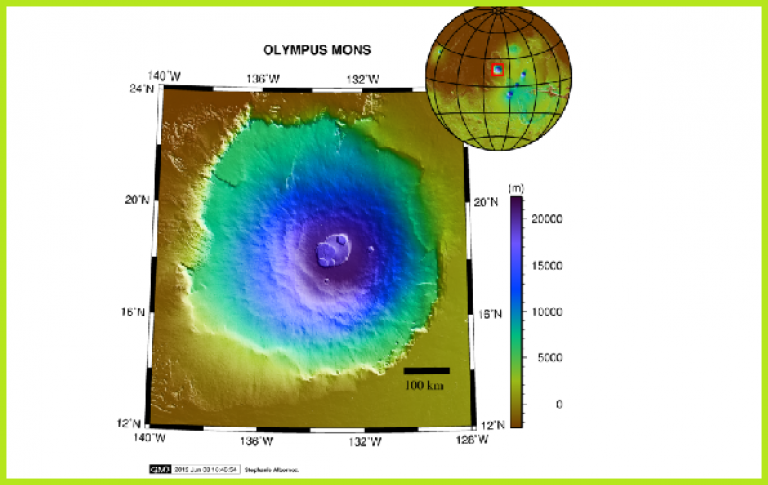How hot is the lava in the volcano Olympus Mons on Mars?
Thank you for your question.

13 September 2022
Image credit: Wikimedia Commons
Olympus Mons is the biggest volcano in the solar system (that we have found so far) and although humans have yet to visit the red planet (Mars), scientists can use the info we do have, to make some predictions.
At roughly three-times the height of Mount Everest (the tallest point on Earth), and the size of France when looking from above, this volcano must have had lots of activity and eruptions to cause it to grow to the size we see today.
As Olympus Mons is so wide, the lava must have been very runny to cause the smooth slopes that we see. This type of volcano with runny lava is called a shield volcano. However, we don’t think that the volcano has erupted recently, and we think it’s been nearly four billion years since it has erupted. Because of this, we think it is a ‘dormant’ volcano- one that is at ‘rest’ as there is not much movement of lava that we can see. Scientists have decided this after looking at lots of images and scientific data that have been collected by satellites and rovers at Mars. They have looked at the rock in lots of detail, and determined the ages of the rocks we see on the surface.
As the rocks we see on the surface are quite old, we would expect them to be cold as they have had lots of time to cool down since they erupted from the volcano. The average temperature on Mars today is -63°C which is very cold! In order for a volcano to erupt, temperatures must be very high to melt rocks into lava, so we know that billions of years ago, when Olympus Mons was active, it would have been a lot hotter. On Earth, when lava erupts from volcanoes it can be between 700 and 1,200°C. The volcanoes on Hawaii are most similar to Olympus Mons, as they have very wide bases and the slopes of the volcano aren’t very steep. Although they are a lot smaller in Hawaii, the volcanoes are very similar. Lava is more-runny when it is hotter, and we know that the lava on Olympus Mons must have been runny to cause the long slopes we see. Because of this, we know the temperature of the lava must have been very hot, and if it is similar to Hawaii then the lava would have been approximately 1,200°C! If the lava was any colder, it wouldn’t have been able to flow down the sides of the volcano and would have caused very steep slopes as the lava built up near the top of the volcano. This would form a different type of volcano, called a strato-volcano. We have these types of volcanoes on Earth, such as Mt St Helens in America.
Although we can’t visit Olympus Mons in person yet, we can learn lots of information about the rocks and how it was formed by using satellites and rovers, and by comparing it to volcanoes that are similar here on Earth. The more we understand about Mars as a whole planet, the more we can determine about the environment in the past and how it has evolved to what we see today.
You can find out more information about Olympus Mons on the BBC Bitesize, NASA and Basic planet websites.
 Close
Close


